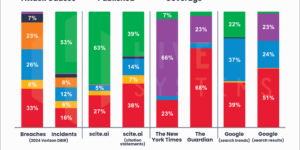North American property/casualty insurers have moved well beyond cautious dabbling into projects involving big data analytics. At the same time, they must find more employees with advanced degrees in analytics and data science to keep the progress moving, Strategy Meets Action determined in a new report.
Consider: In 2012, barely 9 percent of North American insurers invested in Big Data initiatives, SMA noted. While the percentage remains in a minority in 2014, that number has soared to 25 percent of all insurers now, according to the report. Broken down, that includes 14 percent of insurers with under $1 billion in premium, and a whopping 39% with more than $1 billion in premium, according to the SMA study – “Big Data in Insurance.”
“Big Data usage has leapt way beyond the experimentation phase,” SMA analysts wrote in their report. “Five years ago, only the most advanced thinkers in the industry had even heard of big data. A few large firms had embarked on experimentation. But the take-up over the last three years has been nothing short of remarkable.”
SMA explained that big data usage has doubled in the industry over the last year alone. The firm found that property/casualty firms are using or planning to use big data technology for a number of projects involving customer renewal/retention, new business analysis, CRM, distribution segmentation, customer segmentation, customer demographic trends and campaign management.
But big data is also increasingly useful to insurers for customer acquisition, risk planning and evaluation, customer service (policy service, billing, and claims) and enterprise services. More than 44 percent of property-casualty insurers who jumped into big data are using it in areas including new business analytics. About 55 percent deploy the technology for underwriting profitability, and 59 percent do so for claims frequency and severity, SMA said.
One of the most important aspects of this is hiring the right talent and expertise. SMS noted that property/casualty insurers plan to increase their percentage of big data staff with advanced degrees in analytics and data science from 21 percent to 51 percent by 2016. That concentration on hiring folks qualified to move big data to the next level is key, SMA said.
“Assembling a team of businesses and technology experts that understand where and how big data can be applied – and how to interpret and act on it – is perhaps the number one critical success factor,” the report stated. “Analytics officers, data scientists, modeling experts and others in emerging new roles should form the backbone of the team. “But visionaries, big thinkers and subject matter experts in key business areas are just as important.
SMA urges insurers to use a measured approach as they build their use of big data into a number of areas in order to maximize its success as a business tool.
As far as business opportunities in big data, SMA said companies should think “outside the box,” using the technology for everything from custom catastrophe models to the spotting of new product opportunities for a specific segment “based on posts, tweets, likes and favorites.”
As far as technology, SMA urges experimentation and learning, and the accepting of failure as awareness and savvy about using big data for insurance underwriting continues to grow.
“Some investments and projects will not deliver game-changing results,” SMA said in its report. “On the other hand, some projects will hit it big, delivering new insights about customers, products, risks, operations, investments and other business areas. This is the nature of innovation. You can’t win if you don’t play the game.”
Strategy Meets Action is an insurance strategic advisory firm. ISO and SAS sponsored its report; ISO is owned by Verisk Analytics.
Source: Strategy Meets Action




















 Four P/C Insurers Are ‘AI Titans’; AI Impact Leaders Revealed: Research
Four P/C Insurers Are ‘AI Titans’; AI Impact Leaders Revealed: Research  Safeco to Stop Writing New Condo and Renter Policies in California
Safeco to Stop Writing New Condo and Renter Policies in California  Moderating Premium Rates, Falling Yields: European Insurers Resilient
Moderating Premium Rates, Falling Yields: European Insurers Resilient  RiverStone International to Provide Loss Portfolio Transfer for Zurich Insurance
RiverStone International to Provide Loss Portfolio Transfer for Zurich Insurance 








